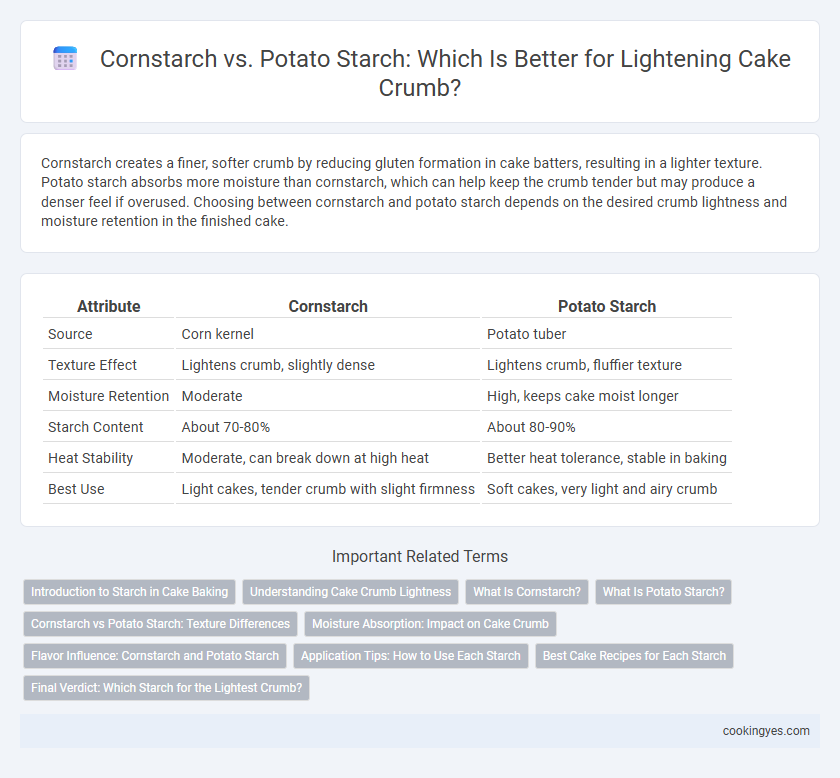Cornstarch creates a finer, softer crumb by reducing gluten formation in cake batters, resulting in a lighter texture. Potato starch absorbs more moisture than cornstarch, which can help keep the crumb tender but may produce a denser feel if overused. Choosing between cornstarch and potato starch depends on the desired crumb lightness and moisture retention in the finished cake.
Table of Comparison
| Attribute | Cornstarch | Potato Starch |
|---|---|---|
| Source | Corn kernel | Potato tuber |
| Texture Effect | Lightens crumb, slightly dense | Lightens crumb, fluffier texture |
| Moisture Retention | Moderate | High, keeps cake moist longer |
| Starch Content | About 70-80% | About 80-90% |
| Heat Stability | Moderate, can break down at high heat | Better heat tolerance, stable in baking |
| Best Use | Light cakes, tender crumb with slight firmness | Soft cakes, very light and airy crumb |
Introduction to Starch in Cake Baking
Cornstarch and potato starch both serve as effective thickeners and moisture retainers in cake baking, improving crumb texture by reducing gluten formation. Cornstarch, derived from maize, is favored for its fine texture and neutral flavor, producing a tender, light crumb with a subtle elasticity. Potato starch, extracted from potatoes, offers superior moisture retention and a slightly denser crumb, enhancing cake softness and shelf life without compromising structure.
Understanding Cake Crumb Lightness
Cornstarch and potato starch both contribute to a lighter cake crumb by reducing gluten development, but cornstarch is more effective due to its finer texture and ability to absorb more moisture. Potato starch, with its larger granules, provides a slightly denser crumb while enhancing moisture retention in the cake. Using cornstarch in cake flour formulations optimizes crumb softness and tenderness, resulting in a delicate and airy texture.
What Is Cornstarch?
Cornstarch is a fine, powdery substance derived from the endosperm of corn kernels, commonly used in baking to improve texture by lightening the crumb. It acts as a tenderizer by inhibiting gluten formation, resulting in a softer, more delicate cake structure. Compared to potato starch, cornstarch provides a slightly denser but still fluffy crumb, making it a popular choice for cakes that require fine, tender textures.
What Is Potato Starch?
Potato starch is a fine, white powder extracted from potatoes that provides excellent moisture retention and a tender crumb in cakes. Unlike cornstarch, potato starch has larger granules that create a lighter, airier texture by preventing dense crumb formation during baking. Its unique ability to absorb and hold water enhances softness and shelf life, making it ideal for lightening cake crumb without compromising structure.
Cornstarch vs Potato Starch: Texture Differences
Cornstarch creates a finer, softer crumb in cakes due to its smaller granule size, resulting in a delicate and tender texture. Potato starch produces a slightly denser crumb with a more moist and chewy bite, as its larger granules retain moisture more effectively. Choosing cornstarch over potato starch lightens the crumb while maintaining a smooth, airy consistency essential for sponge cakes and delicate pastries.
Moisture Absorption: Impact on Cake Crumb
Cornstarch absorbs less moisture than potato starch, resulting in a lighter and more tender cake crumb. Potato starch retains more moisture, which can create a denser texture and a slightly heavier crumb. Choosing cornstarch for cake recipes enhances softness and prevents excessive moisture retention, improving crumb lightness.
Flavor Influence: Cornstarch and Potato Starch
Cornstarch imparts a neutral flavor that enhances light, tender cake crumbs without altering the overall taste, making it ideal for delicate baked goods. Potato starch offers a slightly earthy note but contributes exceptional moisture retention and a soft, airy texture to the crumb. Choosing between cornstarch and potato starch depends on the flavor profile desired and the specific crumb characteristics needed for the cake.
Application Tips: How to Use Each Starch
Cornstarch helps absorb moisture and adds tenderness when replacing a portion of flour in cakes, best used at around 1 to 2 tablespoons per cup of flour for a lighter crumb. Potato starch contributes to a moist, fluffy texture and can be used in similar proportions but works well in gluten-free recipes to improve structure without heaviness. For optimal results, sift either starch with dry ingredients to ensure even distribution and avoid clumping in the batter.
Best Cake Recipes for Each Starch
Cornstarch enhances cake crumb by absorbing moisture and creating a delicate, tender texture ideal for sponge and chiffon cakes, while potato starch's superior moisture retention produces a moist, elastic crumb, perfect for denser pound cakes or gluten-free recipes. Best cake recipes using cornstarch include classic vanilla sponge and angel food cakes, where the starch lightens the batter without compromising structure. Potato starch excels in gluten-free chocolate cake and moist butter cakes, ensuring softness and moisture retention throughout baking and storage.
Final Verdict: Which Starch for the Lightest Crumb?
Potato starch produces the lightest, airiest crumb in cakes due to its higher moisture retention and finer texture compared to cornstarch, which tends to create a slightly denser crumb. Cornstarch can still lighten the crumb effectively by softening gluten, but potato starch excels in maintaining moisture and tenderness over time. For achieving the ultimate lightness and delicate crumb structure, potato starch is the preferred choice in cake recipes.
Cornstarch vs Potato starch for lightening the crumb Infographic

 cookingyes.com
cookingyes.com